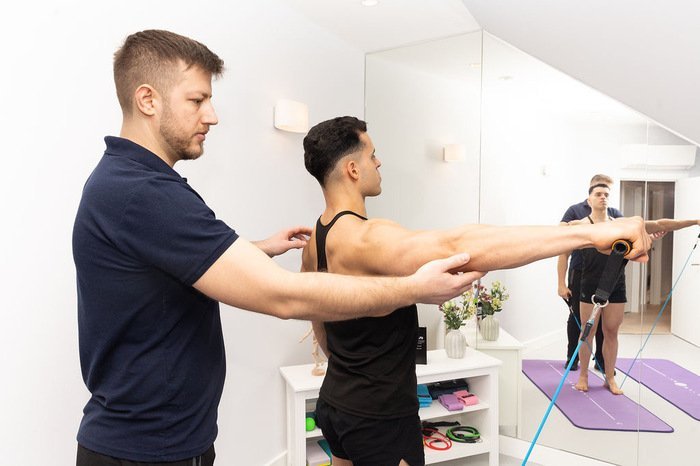Specialist Physical Rehabilitation Techniques for Improved Stamina and Wellness
The domain name of specialist physiotherapy encompasses a range of strategies designed to enhance both toughness and overall health. Central to this technique is the understanding of personalized therapy plans that integrate resistance training, hand-operated treatment, and practical exercises, each serving distinctive functions in rehabilitation.
Comprehending Physiotherapy Concepts
Physical rehabilitation principles are grounded in an all natural understanding of the human body and its action to injury and rehabilitation. These principles emphasize the interconnectedness of physical, emotional, and social aspects that influence an individual's health and wellness. A fundamental element of physical rehabilitation involves evaluating the client's general problem, recognizing impairments, and developing tailored therapy plans that facilitate recovery and boost function.
At the core of physical rehabilitation is the belief in patient-centered treatment, where experts actively involve individuals in their recovery procedure. This joint strategy cultivates motivation and encourages adherence to treatment procedures. Physiotherapists make use of evidence-based techniques to direct their interventions, guaranteeing that strategies and methods are sustained by present study.
An additional secret concept is the importance of motion and function in recovery. Physiotherapists concentrate on bring back mobility, stamina, and control, recognizing that optimal physical feature is critical for overall wellness. Furthermore, education and learning plays a vital function in physical rehabilitation, as experts overview individuals in recognizing their problems and embracing much healthier way of living choices.
Trick Strategies for Strength Structure
Strength building is an essential part of rehab, intended at improving muscle feature and general physical efficiency. Physio therapists utilize various techniques to promote this process, customizing programs to meet private patient requirements.
One secret method is resistance training, which includes workouts utilizing weights, resistance bands, or body weight to boost muscle toughness. This approach successfully targets specific muscle mass groups, advertising hypertrophy and endurance. Another important method is practical training, which focuses on workouts that simulate everyday activities, improving the capability to do regular jobs with better ease and toughness.
Dynamic overload is additionally crucial in strength structure. This concept involves gradually enhancing the intensity of workouts, whether via added weight, enhanced reps, or altered tempo, ensuring continuous adaptation and growth of muscle fibers. In addition, incorporating plyometric workouts can enhance power and quickness, which is especially advantageous for professional athletes and active individuals.
Finally, isometric workouts, where muscles agreement without changing length, can improve stability and toughness in particular joints. By incorporating these methods right into customized recovery programs, physiotherapists can effectively sustain clients in accomplishing their strength-building objectives, ultimately causing boosted functional end results and boosted high quality of life.
Advantages of Guidebook Treatment
Integrating a selection of therapeutic methods enhances the general effectiveness of recovery programs, and manual treatment stands out as a beneficial technique. This hands-on intervention contributes in alleviating discomfort, enhancing flexibility, and facilitating the healing process.
Hands-on treatment encompasses various techniques, including soft tissue mobilization, joint manipulation, and myofascial launch (physio north lakes). These methods intend to lower muscle mass tension, enhance flow, and bring back practical activity. By navigate to this website dealing with soft cells limitations and joint dysfunctions, hands-on treatment can substantially add to pain alleviation and boosted array of movement
In addition, the restorative touch included in hand-operated therapy cultivates a strong patient-provider relationship, promoting trust and convenience. This emotional link can boost person adherence to recovery protocols and total contentment with their care.
Research has actually demonstrated that guidebook treatment can be particularly reliable for conditions such as reduced neck and back pain, neck discomfort, and stress migraines. physio north lakes. As a complementary therapy, it can be incorporated with various other methods, such as workout or techniques, to enhance outcomes. Eventually, the benefits of hand-operated treatment highlight its vital function in comprehensive physical rehabilitation treatment strategies, sustaining both strength improvement and general health
The Function of Exercise Prescription
Exercise prescription plays a critical role in the recovery procedure, offering as a foundational aspect for achieving ideal person results. It includes the methodical planning of physical tasks customized to the individual needs and capabilities of individuals. By taking into consideration elements such as age, physical condition, and details health objectives, physio therapists produce personalized workout programs that cultivate recovery and boost total physical well-being.

Furthermore, exercise prescription fosters patient involvement and possession of the recovery procedure. By proactively joining their recovery, people are most likely to adhere to prescribed routines, leading to improved outcomes. In summary, exercise prescription is a critical part of physical rehabilitation, providing organized, personalized plans that support individuals in their journey toward boosted toughness and overall wellness.
Integrating Mindfulness in Healing
The unification of mindfulness techniques into rehabilitation techniques uses a holistic technique to healing that enhances standard exercise prescription. Mindfulness, defined as the intentional focus on the here important site and now minute, can dramatically improve person results by promoting higher awareness of physical sensations and psychological states. This heightened awareness permits individuals to much better identify discomfort signals and tension responses, promoting more reliable self-regulation.
Research study has actually shown that integrating mindfulness methods, such as reflection and focused breathing, can decrease anxiety and improve psychological strength throughout recovery. These strategies empower patients to manage discomfort and cultivate a favorable way of thinking, which is necessary for adhering to exercise regimens and accomplishing long-term rehab objectives.
Physiotherapists can incorporate mindfulness by directing people through short mindfulness workouts prior to or after physical treatment sessions. This integration not just aids in physical healing but additionally promotes general psychological well-being. Furthermore, training patients to involve in mindfulness during workouts can boost their emphasis, ensuring that motions are carried out with better precision and objective.
Conclusion
